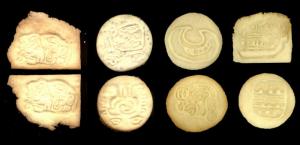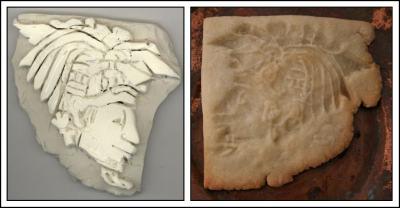Culture Cookies
Some ideas are so persuasive that to avoid them for long is not an option; they yearn to be understood, and often the only sensible choice is to go ahead and try them out. Some, like this one, take a long time to come to fruition and even longer to describe them in as few words as possible!
Some ideas can be uncomfortably abstract, where a well-defined purpose that would justify years of time spent on a dubious project may forever remain vague. But you what, there’s an art to baking a perfect sugar cookie – or any cookie for that matter.
In fact, many of the common products we use were discovered by accident, by going with a gut feeling, or “wingin’ it”. Baking or trying something we don’t normally do eases up the whole state of our being, and it’s surprising how the creativity starts flowing when you’re having fun.
Logic is one-dimensional, creativity is not. Sometimes only by working through the process of an idea do we begin to satisfy a few questions.
______________________________________________________________
The Culture behind the Cookie
Simply put, this project is about the satisfaction of doing your best from start to finish, no matter what that job is. It’s about the joy of creating anything and the unstoppable curious spirit which are really the roots of all Art. Started in 2005, Culture Cookies serve as an Art form (and will be served!) and along with the stamps, demonstrate the fairly crude initial stages and unanticipated steps of the design process as it unfolds from concept to form. For now, I hope to convince you that this is so much more than a cookie!
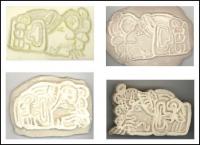 Ideas can lay dormant for years before they are realized. Culture Cookies, a name in mind as work began, were inspired by Mayan hieroglyphs, some of the earliest forms of writing in the whole of the Americas. (origins are Belize, Guatemala, El Salvador and parts of Mexico and Honduras, thriving c. 900 B.C. – 900 A.D., the period from which most of their Art is represented, through 1200 A.D.
Ideas can lay dormant for years before they are realized. Culture Cookies, a name in mind as work began, were inspired by Mayan hieroglyphs, some of the earliest forms of writing in the whole of the Americas. (origins are Belize, Guatemala, El Salvador and parts of Mexico and Honduras, thriving c. 900 B.C. – 900 A.D., the period from which most of their Art is represented, through 1200 A.D.
Art history and cultures are intertwined, and a passing interest back in grade school turned earnest after learning that symbols and pictures are the origins of written language… therefore, of communications as we know them today.
 Further, this project was a venture and an adventure influenced by Art History and lesser known cultures that I’ve studied hands-on informally since about 1993, by recreating various artifacts and incorporating ancient Art forms or replica materials into frames and paintings. During 1994 I made and sold jewelry by imprinting hand-made stamps made from wood or wax onto polymer clay, then painted with acrylics. Adding aged finishes and metallic patinas to unrefined surfaces embedded with ancient symbols felt like finding ancient buried treasure.
Further, this project was a venture and an adventure influenced by Art History and lesser known cultures that I’ve studied hands-on informally since about 1993, by recreating various artifacts and incorporating ancient Art forms or replica materials into frames and paintings. During 1994 I made and sold jewelry by imprinting hand-made stamps made from wood or wax onto polymer clay, then painted with acrylics. Adding aged finishes and metallic patinas to unrefined surfaces embedded with ancient symbols felt like finding ancient buried treasure.  Reading, browsing through books, or visiting a museum to view what earlier Artists made, and imagining them creating their everyday objects is a most inspiring, “real” experience. It is being in touch with the timeless human spirit – one that will still be here when we are not, palpable in the things we do and leave behind…as part of the future’s history!
Reading, browsing through books, or visiting a museum to view what earlier Artists made, and imagining them creating their everyday objects is a most inspiring, “real” experience. It is being in touch with the timeless human spirit – one that will still be here when we are not, palpable in the things we do and leave behind…as part of the future’s history!
 Speaking for myself an Artist, and I think it must be like this for others too, the best way to understand something completely is to just go ahead and do it, whether it’s as “invisible” as an idea, or as concrete as drawing a portrait to understand the structure of a face. Every once in a while the question arises about what it means to be an Artist, and it’s usually then I’m motivated to reinterpret some kind of visual Art from the past into a modern Art form.
Speaking for myself an Artist, and I think it must be like this for others too, the best way to understand something completely is to just go ahead and do it, whether it’s as “invisible” as an idea, or as concrete as drawing a portrait to understand the structure of a face. Every once in a while the question arises about what it means to be an Artist, and it’s usually then I’m motivated to reinterpret some kind of visual Art from the past into a modern Art form. Recreating some object or learning a technique like sewing beadwork, or studying an Impressionist Master’s painting style, I feel the strongest sense of purpose, identifying with the same kind of curiosity and ambition, the same need to think and see and try; the same drive to understand what is beyond our selves.
Recreating some object or learning a technique like sewing beadwork, or studying an Impressionist Master’s painting style, I feel the strongest sense of purpose, identifying with the same kind of curiosity and ambition, the same need to think and see and try; the same drive to understand what is beyond our selves.
Cookies as Art
Writing and language are diverse, but there are many shapes and symbols common and easily  recognizable by all. Globally we are all familiar with the shapes of the moon and sun, regardless of which language we speak. These identifiable symbols and relatable “words” were some of the first chosen for cookies, because anyone eating them would easily learn a tiny bit, feel good about that, and maybe want to learn more.
recognizable by all. Globally we are all familiar with the shapes of the moon and sun, regardless of which language we speak. These identifiable symbols and relatable “words” were some of the first chosen for cookies, because anyone eating them would easily learn a tiny bit, feel good about that, and maybe want to learn more.
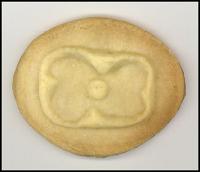 It’s surprising that only a few people in the entire world have begun deciphering the ancient Mayan hieroglyphs, with most of the progress made only within the last fifty years. I was curious to know if the reason was because it was extremely difficult, or if there just weren’t too many people interested enough. I fantasize about what it might be like to be an archeologist deciphering script, and have practiced a lot of line drawings from symbol examples provided in books, then as confidence grew that I had grasped the style, I ad-libbed some cookie patterns from stone wall carvings, and one is of an architectural detail, which is a theme I’d like to try more of if I ever make new stamps. Each drawing was duplicated onto polymer clay in reverse to how it appears on the final cookie, something I didn’t think of until after a few stamps were done.
It’s surprising that only a few people in the entire world have begun deciphering the ancient Mayan hieroglyphs, with most of the progress made only within the last fifty years. I was curious to know if the reason was because it was extremely difficult, or if there just weren’t too many people interested enough. I fantasize about what it might be like to be an archeologist deciphering script, and have practiced a lot of line drawings from symbol examples provided in books, then as confidence grew that I had grasped the style, I ad-libbed some cookie patterns from stone wall carvings, and one is of an architectural detail, which is a theme I’d like to try more of if I ever make new stamps. Each drawing was duplicated onto polymer clay in reverse to how it appears on the final cookie, something I didn’t think of until after a few stamps were done.
A list of line drawings and their meanings follows this article, so you can see how the symbols for ‘sun’ (above) and ‘book’ are fine if drawn backwards or forwards (hey, maybe they were the first palindromes!), but other drawings had to be accurate in the direction of design, like ‘Wind God’. I’m not positive, but my guess is that facing another direction could imply another meaning. It seems like that should have been obvious, but looking back now, I see that most efforts went into finding the process and the materials, so predicting important details like that were not confronted until I came to them. Speaking of details, too many of them in a cookie stamp design results in a very boring cookie! Here is an example:
The idea that a cookie could actually be called Art might seem a bit of a stretch, but whether baking or drawing or painting walls, the finished job depends on how well every other thing is done from start to finish. There is an art to everything.
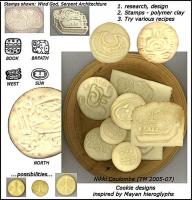 A person could spend a lifetime perfecting hand-made cookie cutters! Properties of the dough even make a difference; baking powder in the recipes causes the some detail to flatten out during baking, so this means stamp designs should be kept simple and imprint deep enough to retain the impression. Some unexpected surprises meant doing/redoing more work, but some were so perfect it was uncanny.
A person could spend a lifetime perfecting hand-made cookie cutters! Properties of the dough even make a difference; baking powder in the recipes causes the some detail to flatten out during baking, so this means stamp designs should be kept simple and imprint deep enough to retain the impression. Some unexpected surprises meant doing/redoing more work, but some were so perfect it was uncanny.
One of the recipes used is called Mexican Borrachio Cookie that includes anise seeds soaked in rum. The recipe was chosen because it was traditionally Mexican, and it didn’t occur to me that the cookie dough would resemble the texture of stone, ideal for the hieroglyphic theme. Then, to make use of every bit of dough, cracked edges and all, I discovered “ancient cookie ruins”! Well, I have my dream-job after all as archeaologist, but it’s the surreal version!
A lot of time was spent finding the appropriate material to make stamps, refusing to pay $30 per inch for a custom rubber stamp that probably wouldn’t be sufficient anyway, and totally missing the point to pay ten times that much to order cookie cutters created with proper materials like tin or plastic. The stubborn compulsion was to experience the rawest creation process from start to finish.
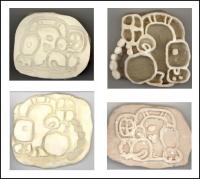 The stamps: carved wood, soft foam and foam board did not work well at all, and tracing the drawing with string glued onto a hard surface was unsuccessful…then tried a few different techniques with polymer clay before finally settling on a combined building/carving/rebuilding process. The results were much larger than originally intended and their appearance doesn’t reflect the amount of time spent. They look handmade, and the next round of efforts to make some will be toward perfecting their quality. Because of the uneven surface, more effort was required to do the impression well, which in turn affected the baked outcome, causing a few cookies to come out of the oven dark on one side and not the other. Care was taken pressing each and every one into the dough, which also should be a certain thickness. It’s necessary to know the geography of these stamps, and learn just where to press harder or lighter, and the stamps need to be clean and floured often. Who knew it would become a regular science experiment?
The stamps: carved wood, soft foam and foam board did not work well at all, and tracing the drawing with string glued onto a hard surface was unsuccessful…then tried a few different techniques with polymer clay before finally settling on a combined building/carving/rebuilding process. The results were much larger than originally intended and their appearance doesn’t reflect the amount of time spent. They look handmade, and the next round of efforts to make some will be toward perfecting their quality. Because of the uneven surface, more effort was required to do the impression well, which in turn affected the baked outcome, causing a few cookies to come out of the oven dark on one side and not the other. Care was taken pressing each and every one into the dough, which also should be a certain thickness. It’s necessary to know the geography of these stamps, and learn just where to press harder or lighter, and the stamps need to be clean and floured often. Who knew it would become a regular science experiment?
 If I were to bake thousands of cookies or hire another company to do the work, these imperfect stamp prototypes would be very impractical, time-consuming and costly. However…this is the summary and the point: someone has to search out and establish all the unknowns in the steps to realizing an idea…steps that might be boring and trivial to others, but are exactly the kind of thing Artists love to try and solve.
If I were to bake thousands of cookies or hire another company to do the work, these imperfect stamp prototypes would be very impractical, time-consuming and costly. However…this is the summary and the point: someone has to search out and establish all the unknowns in the steps to realizing an idea…steps that might be boring and trivial to others, but are exactly the kind of thing Artists love to try and solve.
The Art of Joy
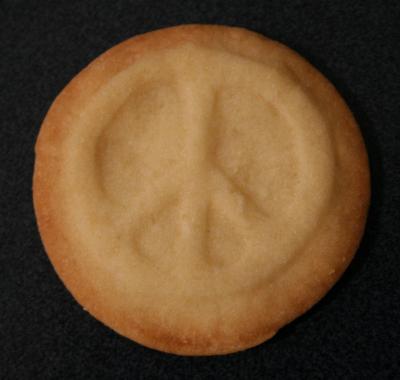 Somewhere amongst the polymer clay and cookie dough I realized that I was having fun and not taking work so seriously. I reflected that an Artists’ responsibility also includes interpreting every bit of fun and joy that comes along too. I loved the absurdity of linking Art and historic facts with an ordinary cookie. I thought about how we are easily aware of our cultural differences, even if we speak the same language, neighbor to neighbor, and within our own families — whoever and wherever we are — but don’t we all like cookies?! Coincidentally, the word “cookies” in computer lingo refers to stored information. It’s a baked enigma!
Somewhere amongst the polymer clay and cookie dough I realized that I was having fun and not taking work so seriously. I reflected that an Artists’ responsibility also includes interpreting every bit of fun and joy that comes along too. I loved the absurdity of linking Art and historic facts with an ordinary cookie. I thought about how we are easily aware of our cultural differences, even if we speak the same language, neighbor to neighbor, and within our own families — whoever and wherever we are — but don’t we all like cookies?! Coincidentally, the word “cookies” in computer lingo refers to stored information. It’s a baked enigma!
Whimsy is sometimes dismissed in favor of producing “Fine Art”, but trying out serendipitous ideas and experimenting feeds Artists’ creative energy, leading to new ideas, reinvigorating work habits.
Throughout the passage of time, Art changes from functional to Spiritual, to intellectual, to questionable! Mass-manufacturing has virtually eliminated human error (unless we’re talking about ethics!) reduced certain laborious steps, cuts time and costs and ideally, but not always, creates a better product. For the Artist though, quality matters. Care matters. Work is meaningful. Work is personal, and there is a strong sense of duty toward ideal standards. There is a committment to furthur whatever the Artists who passed before us sought – it’s the same search for expression and understanding.
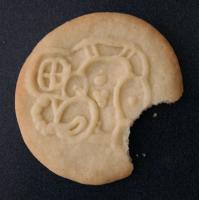 It would be nice if everyone could identify with our intentions, but the real motivation needs to come from within, it really does, especially for those of us who work at home. Trusting our intuition can sometimes find us standing on shaky ground…but it could also be the means to a breakthrough. Something happens during the act of trying to try it out. For me, projects like this help me to trust the raw process of creativity – it’s the other half. Work can be compatable with home.
It would be nice if everyone could identify with our intentions, but the real motivation needs to come from within, it really does, especially for those of us who work at home. Trusting our intuition can sometimes find us standing on shaky ground…but it could also be the means to a breakthrough. Something happens during the act of trying to try it out. For me, projects like this help me to trust the raw process of creativity – it’s the other half. Work can be compatable with home.
The extra-silly little things that we think are trivial might just lead us to the very thing we work so hard to achieve: joy. Some answers are right there in front of your face…literally, like in a cookie.
______________________
The Hieroglyphs
 K’uh – symbol meaning “the essence within”, “holy things”, a god.
K’uh – symbol meaning “the essence within”, “holy things”, a god.
 Figure detail from one of the carved stone benches in Temple XIX Palenque, Chiapas, Mexico with scenes depicting the creation of the world. Classic Period 250-550 A.D. (Common Era). Cookies made from this stamp proved that designs for cookie stamps should be very simple; fewer lines and details yield better results.
Figure detail from one of the carved stone benches in Temple XIX Palenque, Chiapas, Mexico with scenes depicting the creation of the world. Classic Period 250-550 A.D. (Common Era). Cookies made from this stamp proved that designs for cookie stamps should be very simple; fewer lines and details yield better results.
 Architectural detail – my interpretation of the stone-carved serpent deities prominently featured on the once brightly painted Temple of Quetzelcoatl, Teotihuacan., Mexico c. 250 A.D. (Common Era).
Architectural detail – my interpretation of the stone-carved serpent deities prominently featured on the once brightly painted Temple of Quetzelcoatl, Teotihuacan., Mexico c. 250 A.D. (Common Era).
 Wind God, the patron for the month, Mak (making the assumption that the month is March because it is also said to be a variation of the number three). The earring forms the hieroglyph meaning “wind” or “breath”.
Wind God, the patron for the month, Mak (making the assumption that the month is March because it is also said to be a variation of the number three). The earring forms the hieroglyph meaning “wind” or “breath”.
 Book, or the word “hu’un” also meaning “paper”. There were apparently other ways to portray this word. Paper was made from shredded fig tree bark. Books, with paper folded like an accordian and placed between two covers made of wood or jaguar skin, were stored in boxes, similar to the way it was done in India and Japan.
Book, or the word “hu’un” also meaning “paper”. There were apparently other ways to portray this word. Paper was made from shredded fig tree bark. Books, with paper folded like an accordian and placed between two covers made of wood or jaguar skin, were stored in boxes, similar to the way it was done in India and Japan.
 Jaguar – partial image in a phrase not yet interpreted, this symbol is thought to be a jaguar. Part of a stone relief wall carving in Olvidado Temple, or Forgotten Temple, a building built for King K’inch Janaab Pakal of Palenque who ruled between 615 – 683 A.D. (Late Classic Period).
Jaguar – partial image in a phrase not yet interpreted, this symbol is thought to be a jaguar. Part of a stone relief wall carving in Olvidado Temple, or Forgotten Temple, a building built for King K’inch Janaab Pakal of Palenque who ruled between 615 – 683 A.D. (Late Classic Period).
 Moon – as drawn, shows the moon in it’s crescent-shaped phase, displaying shadows.
Moon – as drawn, shows the moon in it’s crescent-shaped phase, displaying shadows.
 Sun, shown as a flower shape with four petals appearing frequently inside or as part of other words, recognizable in some of the pictures of different gods (see Jaguar, East, and West images).
Sun, shown as a flower shape with four petals appearing frequently inside or as part of other words, recognizable in some of the pictures of different gods (see Jaguar, East, and West images).
 Star – The word “ek” means “star”, with a curious-looking symbol, apparently similar to the letter ‘W’ in the Mayan alphabet.
Star – The word “ek” means “star”, with a curious-looking symbol, apparently similar to the letter ‘W’ in the Mayan alphabet.
The next four hieroglyphs refer to the directions on the modern-day compass, discovered on the four walls of a ruler’s burial tomb in Rio Azul, Peten, Guatemala. Early Classic 450 A.D. Common Era. (Book source: Maya Kings of the Rainforest). Gathering from the repetition of certain traits in words, I interpreted the two shapes along the bottom portion of each symbol as clenched hands. West shows a hand with fingers pointing to the right. Also notice the word for Sun included inside the glyph for “West”.
 North – Writing on the north wall of the tomb tells the story of the ruler’s funeral.
North – Writing on the north wall of the tomb tells the story of the ruler’s funeral.
 South – This symbol translates as the word “nojool”, meaning “right”, the explanation being that when looking toward the eastern direction the sun is always on the right side.
South – This symbol translates as the word “nojool”, meaning “right”, the explanation being that when looking toward the eastern direction the sun is always on the right side.
 East – The Mayan word for East is “k’in”, meaning “where the sun emerges”. Note the sun symbol as part of this hieroglyph.
East – The Mayan word for East is “k’in”, meaning “where the sun emerges”. Note the sun symbol as part of this hieroglyph.
 West – The Mayan word “aach k’in” means “where the sun goes in the underworld”. Gifts of food and possessions were offered to the various gods existing in this Underworld.
West – The Mayan word “aach k’in” means “where the sun goes in the underworld”. Gifts of food and possessions were offered to the various gods existing in this Underworld.
___________________________
The Recipes
The two rolled-cookie dough recipes follow. One is for a traditional Sugar Cookie and the other, called Mexican Borrachio cookies, was chosen appropriately for the Mayan theme designs.
* Unlike a painting, for best results stick to the exact measurements in the recipe. Simple cookie cutters are available at dollar stores, and a good selection of symbol shapes can be purchased at major craft stores for around $5 each…or you could try creating a few stamps of your own.
** The dough can be made, divided up and frozen for months, or refrigerated for a few weeks and baked a tray at a time if you prefer, so it’s not necessary to commit to a whole day.
*** Good luck, enjoy!
Traditional Almond Flavored Sugar Cookies
3 1/2 c. flour 1 tsp. baking powder 1/2 tsp. salt
1 c. butter 1 1/2 c. white sugar 2 eggs 1 tsp. vanilla 1 1/2 tsp. almond flavoring
1. In one bowl combine: 3 1/2 c. flour, 1 tsp. baking powder , 1/2 tsp. salt Set aside.
2. In a larger bowl cream together: 1 c. butter and 1 1/2 c. white sugar
3. To this add: 2 eggs, 1 tsp. vanilla, 1 1/2 tsp. almond flavoring Beat mixture until smooth and creamy.
4. Add flour mixture, stirring in half at a time until well blended. Split into three parts (or more if you want to bake only a tray at a time). Wrap dough in plastic or place in a container. Chill for at least half an hour before rolling and cutting.
5. Heat oven to 350*F. Roll out one portion of the dough on a smooth, flat, floured surface. Thickness should be 1/8″ for crisp cookies, thicker for soft ones. Dip cookie cutters and any utensils in flour frequently, and re-flour rolling surface to prevent from sticking. Bake for 8 – 10 minutes.
___________________________________________________________
Mexican Borrachio Cookies
The recipe calls for anise seeds soaked overnight in rum, and if all you do is sit beside the counter smelling the aroma of that mixture you will be glad that at least you started to bake! The seeds worked well with the hieroglyphic theme too, because they show a granite-like texture, a perfect little unexpected detail for some of the Culture Cookie designs.
3 tbsp. anise seeds 3 tbsp. rum 1 1/4 c. butter 1 1/2 tsp. vanilla 1/2 tsp. salt
3/4 c. white sugar 1 egg 2 1/2 c. flour 1 tsp. baking powder 1 1/2 tsp. cloves
1. Soak 3 tbsp. anise seeds overnight in 3 tbsp. rum
2. Next day: Blend together 1 1/4 c. butter, 1 1/2 tsp. vanilla and 3/4 c. white sugar until smooth.
3. Stir in anise seed mixture, then beat in 1 egg until smooth and creamy.
4. In a separate bowl combine: 2 1/2 c. flour, 1/2 tsp. salt, 1 tsp. baking powder and 1 1/2 tsp. cloves.
5. Pour half of this flour mixture into the butter mixture, stir smooth. Then add the rest, combine well.
6. Split into three parts (or more if you want to bake only a tray at a time). Wrap dough in plastic or place in a container. Chill for at least half an hour before rolling and cutting. 7. Heat oven to 350*F. Roll out one portion of the dough on a smooth, flat, floured surface. Thickness should be 1/8″ for crisp cookies, thicker for soft ones. Dip cookie cutters and any utensils in flour frequently, and re-flour rolling surface to prevent from sticking. Bake for 8 – 10 minutes.
______________________________________________________________
List started of book sources and interesting reading (alphabetically):
Canadian Art From its Beginnings – Anne Newlands, 2000 Firefly Books Ltd. ISBN I-55209-450-2
Eskimo Art – Cotties Burland, The Hamlin Publishing Group Ltd., 1973 ISBN 0-600-33083-4
Great Civilizations Macropeadia – Dempsey Parr, 1999 ISBN 1-84084-444-2
Jaguar and Serpent The Cosmos of the Indians in Mexico, Central and South America– Claus Deimel and Elke Ruhnau ISBN 3-496-027002-2
Maya Divine Kings of the Rainforest – edited by Nicolai Grube ISBN 3-8290-4150-0 (highly recommended!)
Native American Art and Folklore, A Cultural Celebration – David Campbell, 1998 Brompton Books Corporation ISBN 0-517-06975-8
Principles of Decorative Design – Christopher Dresser, 1973 Acadamy Editions SBN 85670 062-2
The Bhagavad Gita – translated for the modern reader by Eknath Easwaran, 1985 5th printing 1990 ISBN 0-915132-36-2 Order this and other books by this Author directly: Nilgiri Press, Box 256, Tomales, California 94971
The Encyclopedia of North American Indian Tribes – Bill Yenne 1986 Bison Books Ltd. ISBN 0-86124-271-8
The Encyclopedia of Signs and Symbols – John Laing and David Wire, 1993 Crescent Books ISBN 0-517-07696-9
The Four Corners Timeless Lands of the Southwest – Kathleen Bryant, 2003 Northland Publishing ISBN 0-87358-830-4
The Incredible Incas and Their Timeless Land – Loren McIntyre, 1975 Published by The National Geographic Society (no ISBN)
The Smithsonian Book of North American Indians Before the coming of the Europeans – Philip Kopper, Smithsonian Books ISBN 0-89599-018-0, ISBN 0-8109-1510-3 (Abrams)
The Zen of Seeing, Drawing as Meditation – Drawn and hand-written by Frederick Franck, 1973 Random House Inc. New York
Through Indian Eyes The Untold Story of Native American People, Reader’s Digest Association Inc. ISBN 0-89577-819-6


